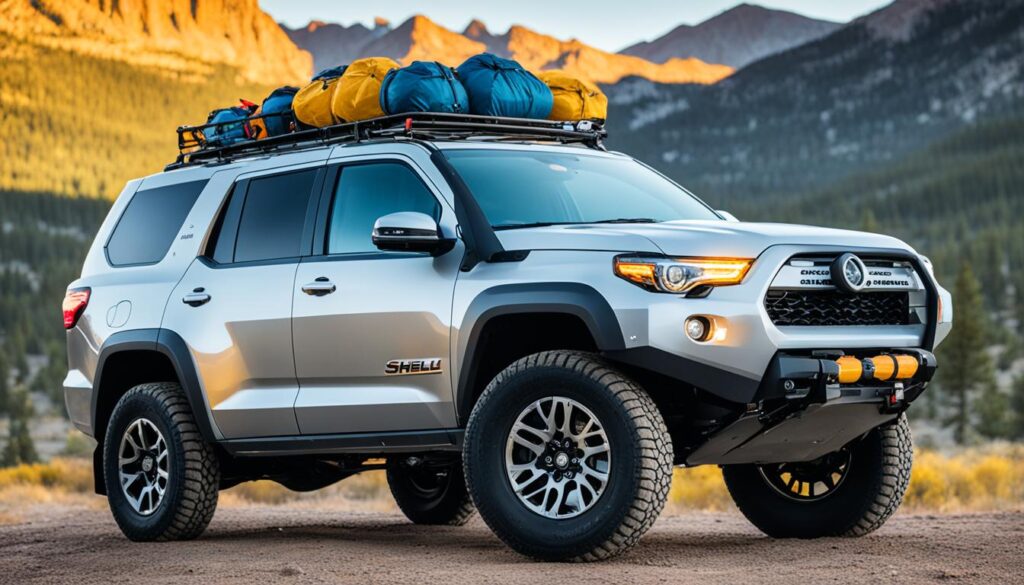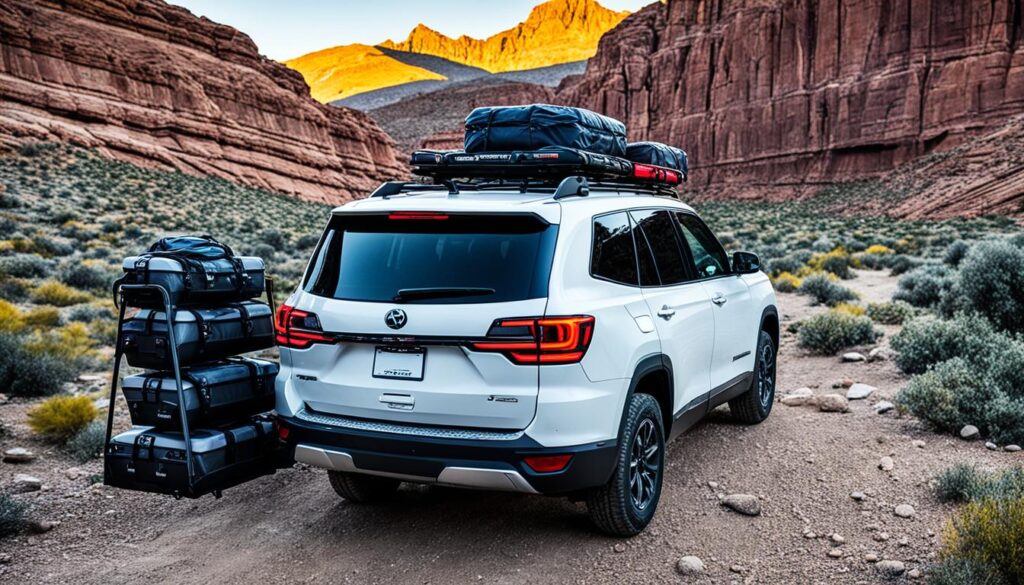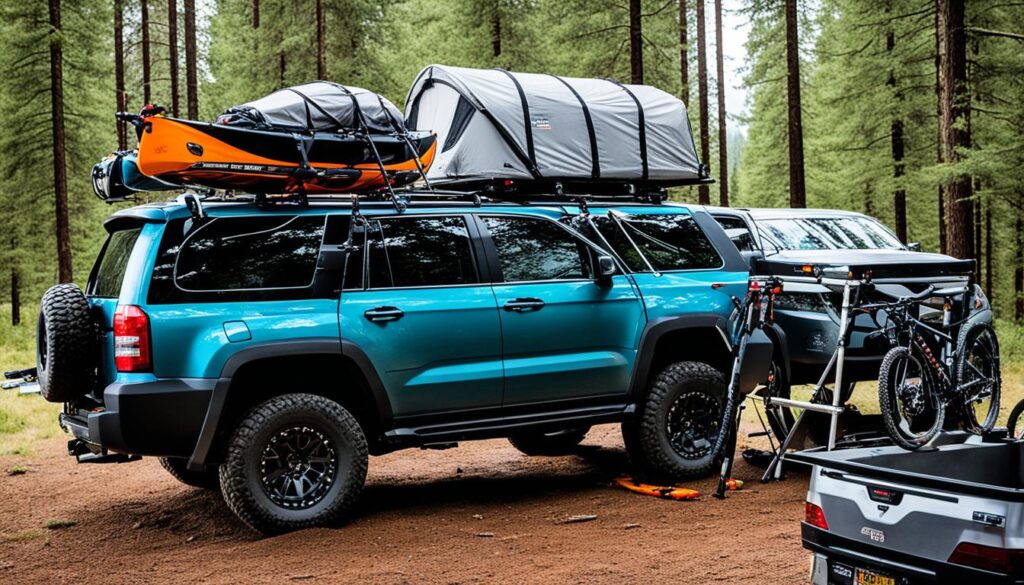When it comes to overlanding, choosing the right equipment is essential for a successful and enjoyable adventure. Two popular options for gear storage are racks and shells. But which one is the better choice? Which option offers the most benefits and versatility for your overlanding needs?
In this article, I will explore the pros and cons of using racks and shells for overlanding. We will delve into the benefits of each option, their functionality, and how they can optimize your overlanding setup. Whether you’re a seasoned overlander or planning your first trip, understanding the differences between racks and shells will help you make an informed decision.
Key Takeaways:
- Racks offer versatility and strength for mounting various accessories.
- Shells provide secure and dry storage for gear but may lack durability for off-roading.
- Consider factors such as load capacity, functionality, and vehicle type when choosing between a rack and a shell.
- Roof racks and truck bed racks offer different mounting options for gear and accessories.
- Compatibility between racks/shells and roof top tents or bed/tonneau covers should be considered.
If you choose to go with a rack for your overlanding setup, you’ll open up a world of possibilities and advantages for optimizing your overlanding experience. Racks provide numerous benefits that can enhance the functionality and convenience of your vehicle. With a wide range of rack options available, you can customize your setup based on your specific needs and preferences.
Roof Racks
Roof racks, such as those from Prinsu Design Studio and Front Runner, offer a sturdy and versatile mounting platform for overlanding gear and accessories. These racks can be paired with crossbars, load panels, and accessory mounts, allowing you to create a customized setup to suit your specific requirements. Whether you need to mount a roof top tent, storage boxes, or lighting solutions, roof racks provide the flexibility to optimize your storage space and carry all the essentials for your adventure.
Truck Bed Racks
If you have a pickup truck, truck bed racks provide an excellent option for overlanding. Brands like RCI Off Road and Cali Raised offer durable truck bed rack options that allow you to store gear in the bed while still being able to mount accessories above. This flexibility is perfect for organizing and securing your equipment, ensuring easy access and maximizing your available storage space. Whether you want to mount additional fuel or water containers, recovery equipment, or a rooftop tent, truck bed racks provide the ideal solution.
Advantages of Using a Rack for Overlanding
The benefits of using a rack for overlanding are numerous and can significantly improve your overall experience. Here are some key advantages of incorporating a rack into your setup:
- Maximize storage space: Racks allow you to make the most of the available space on your vehicle, efficiently organizing and storing all your gear and equipment.
- Improve off-road capabilities: By installing a rack, you can distribute the weight of your gear more evenly, enhancing your vehicle’s balance and stability during off-roading adventures.
- Enhance functionality: Racks provide a mounting platform for various accessories, such as roof top tents, awnings, and lighting, enabling you to tailor your setup to your specific needs and preferences.
- Easy installation and removal: Most racks are designed to be easily installed and removed, allowing for quick setup and reconfiguration when needed.
Optimizing Your Overlanding Setup
When choosing a rack for your overlanding adventures, consider factors such as load capacity, compatibility with your vehicle, and the type of gear you plan to carry. It’s important to choose a rack that can handle the weight of your equipment and is specifically designed for your vehicle model. By optimizing your overlanding setup with a suitable rack, you’ll be able to maximize storage space, improve off-road capabilities, and enjoy the advantages of a versatile and customized setup that meets your unique needs.
Shell Options for Overlanding
If you prioritize secure and dry storage, a shell may be the better option for you. Truck camper shells, like those from Leer and Snugtop, provide a weatherproof enclosure for your gear.
They are great for protecting your equipment from the elements and keeping it safe from theft during your overlanding adventures. However, it’s important to note that fiberglass shells may not be as durable as some other options, especially for off-roading. If you plan on doing a lot of off-road driving, consider the durability and impact resistance of the shell.

Why Choose a Shell?
A shell offers several advantages for overlanding enthusiasts:
- Secure Storage: With a shell, you can lock up your gear and ensure it remains safe and protected during your journeys.
- Weatherproof: Whether it’s rain, snow, or intense sunlight, a shell provides a reliable barrier against the elements, keeping your gear dry and undamaged.
- Easy Access: Unlike roof racks, which often require a ladder to reach, shells offer convenient access to your gear from ground level, minimizing the need for climbing.
- Aesthetic Appeal: Shells can enhance the overall look of your vehicle, giving it a more streamlined and professional appearance.
Choosing the right gear for overlanding is crucial for a seamless and enjoyable adventure. While a shell may limit some off-road capabilities compared to racks, it provides ample storage space and peace of mind when it comes to gear security and protection.
Capacity and Load Rating
When it comes to choosing between a rack and a shell for overlanding, one of the crucial factors to consider is the capacity and load rating of the equipment. Racks are designed with dynamic load ratings, which determine the maximum weight they can safely handle while your vehicle is in motion.
In order to ensure the safety and stability of your overlanding setup, it’s important to calculate the estimated weight of all the gear you plan to carry and confirm that it falls within the dynamic load rating of the rack. This calculation includes the weight of items such as roof top tents, storage boxes, and any additional accessories you intend to mount on the rack.
Moreover, it’s worth noting that racks may also come with static load ratings, which determine the total load they can handle when the vehicle is at rest. Taking into account the weight of your tent, gear, and the number of occupants, make sure that the rack you choose can support the total load you plan to carry.
Optimizing Load Capacity with a Rack
By choosing the right rack and ensuring that it aligns with your load capacity requirements, you can optimize your overlanding setup in several ways:
- Maximize Storage Space: Racks provide ample space for mounting various accessories, allowing you to free up valuable interior space in your vehicle. This means you can carry essential gear and supplies without compromising on comfort or accessibility.
- Improve Off-Road Capabilities: Racks are designed to withstand the challenges of off-roading, offering durability and stability even in rugged terrains. With a rack, you can confidently navigate through rough trails, knowing that your gear is securely mounted and won’t hinder your vehicle’s performance.
- Enhance Overlanding Functionality: By utilizing a rack, you have the flexibility to customize your setup according to your specific needs. Whether you need to mount extra fuel canisters, recovery equipment, or lighting solutions, a rack provides the necessary platform to optimize your overlanding experience.
When it comes to improving your overlanding capabilities, a rack is an invaluable asset that ensures you have the necessary load capacity and support for all your gear. Whether you’re embarking on a weekend camping trip or a long-term off-road adventure, investing in a reliable rack solution is essential for optimizing your overlanding setup.
Roof Racks vs Truck Bed Racks vs Load Bars
When it comes to overlanding gear essentials, choosing the right equipment is crucial for optimizing your overlanding setup. If you decide to go with a rack, whether it’s a roof rack or a truck bed rack, you’ll have various options to consider.
Roof racks, such as those from Prinsu Design Studio and Front Runner, provide a sturdy and versatile platform for mounting gear and accessories. These racks can be customized with crossbars, load panels, and accessory mounts to meet your specific needs. With a roof rack, you can maximize your storage space and securely transport items like roof top tents, storage boxes, and lighting.
On the other hand, truck bed racks offer a different approach for overlanding. Brands like RCI Off Road and Cali Raised provide racks that allow you to store gear in the bed of your truck while also offering the option to mount accessories above. This setup gives you the flexibility to organize your equipment and optimize your vehicle’s off-road capabilities.
In addition to roof racks and truck bed racks, another alternative for overlanding is the use of load bars. Also known as roof bars or bed bars, these bars provide a simple and practical solution for trucks and SUVs. With load bars, you can easily secure and transport your gear without the need for a full rack system.
When choosing between these different rack options, it’s important to consider your specific needs, the type of gear you plan to carry, and the configuration of your vehicle. Take into account factors such as load capacity, ease of installation, and compatibility with other accessories.
Roof Top Tents and Bed/Tonneau Covers
If you plan on using a roof top tent (RTT) for overlanding, it’s important to consider the compatibility with your chosen rack or shell. Most RTTs have universal U-shaped mounting brackets that can be mounted to crossbars or the mounting points on a rack. However, the weight and design of the tent can affect the center of gravity and aerodynamics of your vehicle, especially when driving at highway speeds.
Additionally, if you have a bed or tonneau cover, it may interfere with the installation of a rack. Some manufacturers, like RCI Off Road, offer bed rack tonneau cover adapters to solve this issue and allow for the integration of a tonneau cover with a bed rack.
Rack Accessories and Style
One of the advantages of using a rack for overlanding is the ability to customize and add accessories to optimize your overlanding setup. With the right accessories, you can enhance both the functionality and aesthetics of your rack.
Accessory Options
When it comes to accessorizing your rack, there are numerous options available. One reputable brand that offers a wide range of accessory attachment hardware parts is Front Runner. Whether you need to carry bikes, kayaks, cargo boxes, or other gear, Front Runner has you covered.
“Front Runner provides the flexibility to add the accessories you need to make your overlanding experience more efficient and enjoyable.”
In addition to general purpose attachment parts, many rack manufacturers also offer specific brackets designed for mounting awnings and roof top tents. These brackets ensure a secure and sturdy connection between your rack and the desired accessory.
Considerations when Choosing Accessories
When selecting accessories for your rack, it’s crucial to consider the weight, size, and functionality of each item. Make sure they are compatible with your chosen rack and do not exceed its load capacity. Remember, optimizing your overlanding setup means finding the perfect balance between versatility and weight distribution.
For example, if you plan on mounting a roof top tent, ensure that your rack can bear the weight and distribute it evenly to maintain stability while driving and maximize off-road capabilities.
Style and Design Options
In addition to functionality, racks come in various styles and designs to suit your personal preference and the overall look of your vehicle. Options range from sleek and low-profile racks to those with wind deflectors or integrated LED light bars.

A rack with a wind deflector can help reduce wind resistance, resulting in improved fuel efficiency and reduced noise during long drives. Meanwhile, racks with integrated LED light bars offer enhanced visibility during nighttime off-road adventures.
Conclusion
When it comes to optimizing your overlanding setup, choosing the right equipment is crucial. The decision between a rack and a shell for your vehicle depends on various factors, such as your specific needs, the type of gear you plan to carry, and your vehicle configuration. Let’s recap the pros and cons of each option to help you make an informed decision.
Racks offer versatility and strength, allowing you to customize your setup with various accessories. With roof racks or truck bed racks, you can maximize storage space and improve off-road capabilities. By mounting accessories like roof top tents, storage boxes, and lighting, you can enhance the functionality of your vehicle for overlanding. Racks also provide the flexibility to choose from different styles and designs, allowing you to match your personal preference and aesthetics.
On the other hand, shells provide secure and dry storage for your gear, protecting it from the elements and potential theft. They are especially useful if you prioritize gear protection during your overlanding adventures. However, it’s essential to note that shells may not be as durable as racks for off-roading. If you plan on doing a lot of off-road driving, consider the durability and impact resistance of the shell.
Ultimately, the choice between a rack and a shell comes down to weighing the benefits against your specific requirements. Consider your priorities, weight capacity needs, and the overall functionality you desire for your overlanding adventures. By carefully assessing these factors, you can make an informed decision and optimize your overlanding setup for a thrilling and enjoyable experience.
FAQ
What are the pros and cons of using a rack versus a shell for overlanding?
Racks offer versatility, strength, and the ability to customize your setup with various accessories. Shells provide secure and dry storage for your gear, protecting it from the elements and potential theft. However, shells may not be as durable as racks for off-roading.
What are some options for racks for overlanding?
Roof racks and truck bed racks are popular options for overlanding. Prinsu Design Studio, Front Runner, RCI Off Road, and Cali Raised are some manufacturers that offer high-quality rack solutions.
What are some options for shells for overlanding?
Leer and Snugtop are well-known manufacturers of truck camper shells that provide secure and weatherproof storage for overlanding gear.
How do I choose a rack or shell with the right capacity and load rating for overlanding?
When choosing a rack or shell, it’s important to consider the dynamic and static load ratings to ensure they can safely support the weight of your gear and occupants.
What are the differences between roof racks, truck bed racks, and load bars for overlanding?
Roof racks are typically used for cars and SUVs, providing a versatile mounting platform for gear and accessories. Truck bed racks offer the flexibility to store gear in the bed and mount accessories above. Load bars, also known as roof bars or bed bars, provide additional support for mounting gear on trucks and SUVs.
How do roof top tents and bed/tonneau covers affect the use of racks for overlanding?
Roof top tents can be mounted to racks or shells, but it’s important to consider the weight and design of the tent and its impact on vehicle stability and aerodynamics. Bed or tonneau covers may require specific adapters to integrate with a bed rack.
What accessories and styles are available for racks in overlanding setups?
Racks offer the ability to customize your setup with various accessories like bike mounts, cargo boxes, and awnings. Different styles, such as low-profile racks or those with integrated LED light bars, allow for personalization based on preferences and aesthetics.






